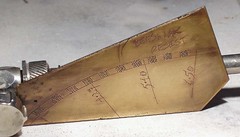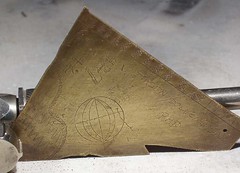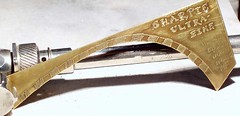I rock the pan every 10 minutes and turn the tests over every 20 minutes. The length of time needed for the etch I want varies, depending on the age of the ferric chloride. Most of my etches take between one and two hours. Please make sure you get all the safety information about etching before you try this. It gives off toxic fumes, and the acid is dangerous.

Beeswax has been my favorite resist for a long time. The line I get is fine. I scratch in the beeswax with an old dental tool, so it's similar to drawing.

To get the inkpad ink on the metal, I just blotted it on. The pad is raised above it's plastic case. Along the edge of the blotted area it leaves a nice texture. I scratched in the ink after it was dry. The Staz-on ink pad is available at Volcano Arts. It's on this page. It works great for etching rubber stamp images. Be sure to get some cleaner at the same time.

The Industrial Sharpie is supposed to resist chemical washes and steam up to 500 degrees. I find it is the best pen resist, but the line isn't very thin. It was easy to find in our local office supply store.

The Sharpie Industrial also comes in extra fine. The scale is deceptive in this photo. The scrap I used for this test is about half as long as the scrap for the industrial fine point Sharpie, so the line is much finer. And this ink also lasts a long time in the acid.

This is the older Sharpie, extra fine. It has black lettering on the side of the pen. After 40 minutes in the acid, the ink started wearing off. I could have cleaned it up and gone over the lines again, but it's hard to put them exactly where they should be.
All these images link to bigger versions on Flickr. They also all appear in my photoset "Testing."
Conclusion: I will definitely make sure I keep both sizes of the new industrial Sharpies around. The ink stays on well in the ferric chloride. I plan to etch the dream focusing device using a combination of the extra fine Sharpie industrial marker and the beeswax for the numbers I want.


2 comments:
Very interesting tests, Judith. I'll be interested to see the finished piece. I don't often get away from paper and paint, but this looks tempting.
Thanks for the etching info. I've been doing photo silkscreen for etching for quite awhile and have recently been doing etching with my students. It's pretty immediate. I'll have to look for the industrial sharpie. I've been using regular sharpie which works ok, but not as well as the FeCl ages and the metal has to remain in the FeCl for longer periods of time. I've red the Staedtler, red, #317 is supposed to work. I used thinned out tar/asphaltum, which works well, as long as your ok with a brush. miketayse@gmail.com
Post a Comment